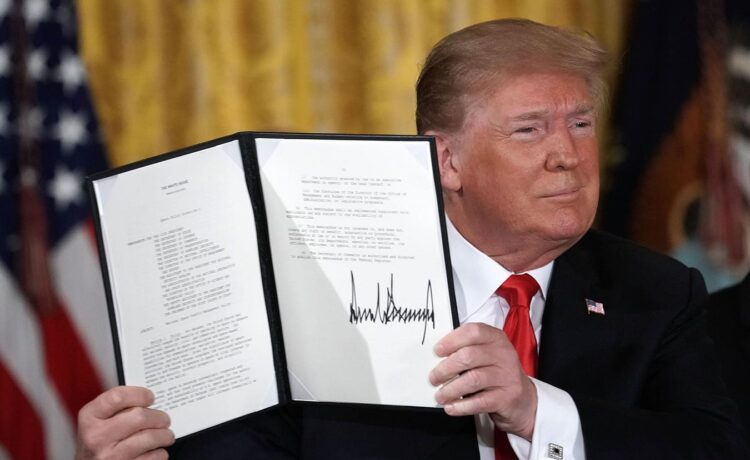U.S. President Donald Trump holds up an executive order. (Photo by Alex Wong/Getty Images)
It’s been a hectic start to Donald Trump’s second term as U.S. President, with the stories coming thick and fast. And the latest of these to cause a storm? That’s the signing of an executive order calling for the creation of a U.S. sovereign wealth fund.
Of course, because it’s the internet, the online reaction has been furious, with people coming out in droves to post about how misguided they believe this move to be:
This story is a fantastic case study of the multi-faceted nature of social media, where it can simultaneously operate as both an information hub and a place to vent emotion.
We’ll get to how this happens in good time, but first, let’s take a quick look at the wider story.
What Is A Sovereign Wealth Fund?
In simple terms, a sovereign wealth fund is an investment fund owned by the state. Often run by a central bank, they invest in an array of assets, including stocks, bonds, metals, and other funds.
The goal of a sovereign wealth fund—which is most commonly found in countries with budget surpluses, little or no debt, and income from oil—can be varied. Sometimes they’re used to stabilize government revenues, to help position a country as a financial center (such as the Korea Investment Corporation), or to provide for future generations, as is partially the case in Norway.
What Happened With The Trump Sovereign Wealth Fund?
Currently, it’s unclear precisely what Trump’s plan with a U.S. sovereign wealth fund would be.
According to the New York Times, the President signed a three-paragraph executive order that commands the Treasury and Commerce Departments with coming up with a plan about how a sovereign wealth fund would work in the United States.
One such example Trump used was the possibility of it being used to fund the purchase of TikTok, yet the precise nature of investment vehicle still needs to be defined.
This didn’t stop the internet from getting pretty frustrated about the entire affair though.
How Did The Internet React To News Of Trump’s Sovereign Wealth Fund?
Overall, the reaction was one of rage and annoyance. The most common response involved people breaking down how they believe the U.S. sovereign wealth fund would be exploited for personal gain by those in power:
While others used examples of how the U.S. invests in public infrastructure as a way of highlighting the perceived ridiculousness of a sovereign wealth fund:
Other posters took a different route, referencing situations where other countries had abused their own sovereign wealth funds:
And some people made jokes about researching what a sovereign wealth fund actually is following Trump’s announcement:
What Does The Angry Social Media Reaction To The U.S. Sovereign Wealth Fund Mean?
There are a couple of elements at play around why people are responding so negatively to the news of the Trump sovereign wealth fund.
The most pressing of these is a form of emotional management. We’re still in the early days of a Trump presidency, something many were vehemently opposed to. This means individuals could still well be struggling with the emotional impact of the election and the news cycle that’s now focused on his decisions and policies.
This is where social media can help.
Research shows that online platforms play “an important role in people’s everyday emotion regulation and mood management,” meaning it can act as a conduit for expressing worry and concern.
If, say, someone is struggling with Trump being in power, then posting something against his policies can feel like taking action, and serve as a way to manage their emotions at the situation.
Another aspect of the social media reaction that’s important is as a narrative contextualizer.
It’s estimated we consume about 74GB of data a day, an amount of information a highly educated person 500 years ago would encounter across their entire lifetime. This leads to a situation where we’re being bombarded with news stories, but simply don’t have the bandwidth to properly process and understand them.
In these moments, social media can step in, something happening in real-time with posts about the U.S. sovereign wealth fund. Whether the information in them is right or wrong isn’t of concern to many, instead, they operate as a summary of not only the news story, but also how people should feel about it.
Over a series of succinct posts, users receive a breakdown, effectively giving them a short path to forming an opinion or viewpoint about what’s happening without investing swathes of time.
Ultimately, the online reaction to the Trump sovereign wealth fund operates as a prime example of how the internet reacts to and manages political news.
On one hand, social media can be an emotional regulator, helping people control their feelings in tumultuous political times. And, on the other, it can be a way for individuals to feel knowledgeable about ongoing narratives.
That’s what’s endlessly fascinating about stories like the sovereign wealth fund: they show social media isn’t a simplistic place, instead it’s endlessly complex and multi-faceted. In other words, a perfect reflection of society itself.




